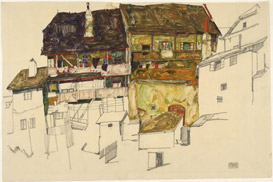
Old Houses in Krumau, 1914
Old Houses in Krumau, 1914
Opaque color and pencil
32.5 x 48.5 cm
Albertina, Vienna
I know there is one in a thousand who lives with love for people, animals, plants, and things, who perceives the organism of all things, who sees in the inner life of plants and in their countenance the living breath of their faces.
—Egon Schiele (1)
Like many other artists of his time, especially in France and Germany, Egon Schiele (1890, Tulln, Austria–1918, Vienna) felt that closeness to nature inspired creativity. (2) He also believed that nature had anthropomorphic qualities. In this way, his landscapes have much in common with his portraits. His gnarled trees have the same jagged outlines as his subjects’ limbs. His sunflowers stand isolated, their surroundings empty, like his alienated portrait subjects. Even the houses of his cityscapes with their lit windows suggest eyes blinking in the night.
Schiele’s landscapes are also part of his search for the divine in nature. Like Romantic artists, he used natural forms that often suggest religious signs or symbols. His trees might evoke the cross, while his woods, the interior of a Gothic church. (3) His poetry continues this theme. In his poem, “Tannenbaum” (Fir Tree, 1910), he wrote: “I enter the red-black cathedral of the dense fir forest that lives unnoisily and in mime beholds itself.” (4)
Schiele’s cityscapes also share commonalities with his portraits. They demonstrate an interest in unusual perspectives and are often viewed from above. To paint his portraits, Schiele was known to stand on a ladder looking down, and for his cityscapes, on top of a tower. The latter reveal his interest in two-dimensional design and yet maintain a spatial integrity.
From 1911 on, Schiele’s approach to landscape and cityscape changed stylistically. His paintings began to take on an aura of decay, loneliness, despair, and impending disaster. His cityscapes depicted old, desolate towns, suggesting a pessimistic view of old age and eventually death. (5)
Old Houses in Krumau (Alte Häuser in Krumau, 1914), depicts a hillside in the suburbs above the Moldau River and crowded with houses. Like his portraits, Schiele leaves out much of the environment, omitting most notably the Moldau and even the details of the houses that border it. The gouache stops before it gets to the lower houses, which are colorless, sketched in black pencil, incomplete structurally, and sporadically shaded. While the painting indicates his interest in two-dimensional design like that of his mentor Gustav Klimt (1862–1918), his additional fascination with structure and line is apparent. The sense of these buildings as “old houses”—including the oldest house in Krumau, Germany (now Český Krumlov, Czech Republic)—comes through; they decay and fall apart before our eyes into an unfinished black-and-white sketch.
1. Helmut Friedel and Helena Perena, eds. Egon Schiele: The Unsalvageable Ego; Works from the Albertina, exh. cat. (Cologne: Wienand, 2012), p. 116.
2. Egon Schiele: The Leopold Collection, Vienna, exh. cat. (Cologne: DuMont; New York: Museum of Modern Art, 1998), p. 19.
3. Friedel and Perena, Egon Schiele, p. 112.
4. Egon Schiele, “Tannenbaum” (1914), quoted in ibid.
5. Egon Schiele: The Leopold Collection, pp. 19 and 238.
Preguntas
Ask students to brainstorm a list of adjectives to describe places. This list could include words such as spacious, sunny, spooky, crowded, and exciting. As a group look at Old Houses in Krumau and ask students to work with a partner to identify words from the list that fit this place. They should back up their choices with evidence from the painting. Would they add new words to the list? What did Schiele do to create a place that evokes the words they have chosen? Encourage them to think about elements such as color, perspective, line, and brushstroke.
Some may say this drawing looks unfinished. Why? Ask students to think about why Schiele made some of the choices that leave it looking unfinished (that is, the lack of color in the bottom half, the houses lacking in structural details, or the missing surroundings). Ask students to think about a time when they have made a work of art. How did they know they were finished?
Schiele often saw human qualities in nature and in the old towns he painted. Many of his works have anthropomorphic elements. Define the word “anthropomorphic” for students and give examples. Read the quote at the beginning of this section aloud. What, if anything, about this drawing do students see as anthropomorphic? Ask them to imagine that these houses could talk. What would they say? How would they act? What would their personalities be like?
Ask students to think about the words “looking” and “seeing.” Do they perceive any difference between the two? Schiele made a distinction between these actions. He considered “looking” more superficial, requiring no particular interest, while “seeing” was, for him, a conscious process that involved perceiving, knowing, judging, and thinking. (1) He said that only painters could truly see. “The painter can look, too,” he said. “But seeing is something more.” (2) What do students think about this idea? Look back at his drawing together. What do they think Schiele saw in these old houses?
1. Friedel and Perena, Egon Schiele, p. 120.
2. Ibid., p. 126.
